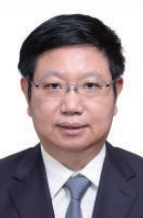Rongming Wang*
University of Science and Technology Beijing, Beijing 100083, China
EXTENDED ABSTRACT: In-situ observation of the evolution of atomic structure, surface and interfacial configuration and electronic state during crystal growth can provide direct experimental evidence for studying micro-mechanism of crystal growth and structure-properties relationship. We used environmental spherical correction transmission electron microscopy (ETEM) to study the nucleation and growth of nanocrystals(NCs) and investigate the surface and interfacial effects on the NCs growth and performances. It was found SWCNTs nucleating from the surface edge of solid catalyst were with diameter smaller than the catalyst size and chiral selectivity, while the ones growing on melting catalyst had catalyst-size dependent diameters and no structural selectivity [1]. We revealed that in the solid phase environment amorphous Pt clusters first grew to a critical size of -2.0 nm and then crystalized, and accordingly proposed Pt NCs nucleation and growth mechanism [2]. Further we found that the side atomic configuration of MoS2, which served as growth substrate, could regulate the size of Pt NCs, and proposed that the strain caused by interfacial configuration and lattice mismatch could regulate the nucleation and growth process of Pt NCs [3]. We also found the strong interaction between Pt and MoS2 could tune the electronic states at the interface and promote the electrocatalytic hydrogen evolution performance of the Pt-MoS2 heterogeneous structure [4]. In a recent review, we summarized the important progress of in-situ TEM in the study of NCs and proposed future research directions [ 5].
Keywords: ETEM; in-situ; nanocrystal nucleation and growth; structure-function relationship
REFERENCES
[1] F. Yang, R.M Wang* and co-authors, Sci. Adv., 8 (41) (2022) abq0794.
[2] H.Y. Ye, R.M Wang* and co-authors, Small Methods, 6 (6) (2022) 202200171.
[3] Y.C. Zhu, R.M Wang* and co-authors, Nano Res., 15 (9) (2022) 8493-8501.
[4] A.X. Shan, R.M Wang* and co-authors, Nano Energy, 94 (2022) 106913.
[5] H.F. Zhao, R.M Wang* and co-authors, Adv. Mater., (2022) doi://10.1002/adma.202206911.

Rongming Wang, Ph.D., is a professor at Beijing Advanced Innovation Center of Materials Genome Engineering, Director of Beijing Key Laboratory for Magneto-Photoelectrical Composite and Interface Science, University of Science and Technology Beijing. His research interests include magnetic nanomaterial, transmission electron microscopy, interface science, and materials genome engineering. He has published 268 papers in reputable journals with citations over 13,000 times and H factor of 61. He has been awarded Highly Cited Chinese Researchers for exceptional research performance in the field of Physics by Elsevier.